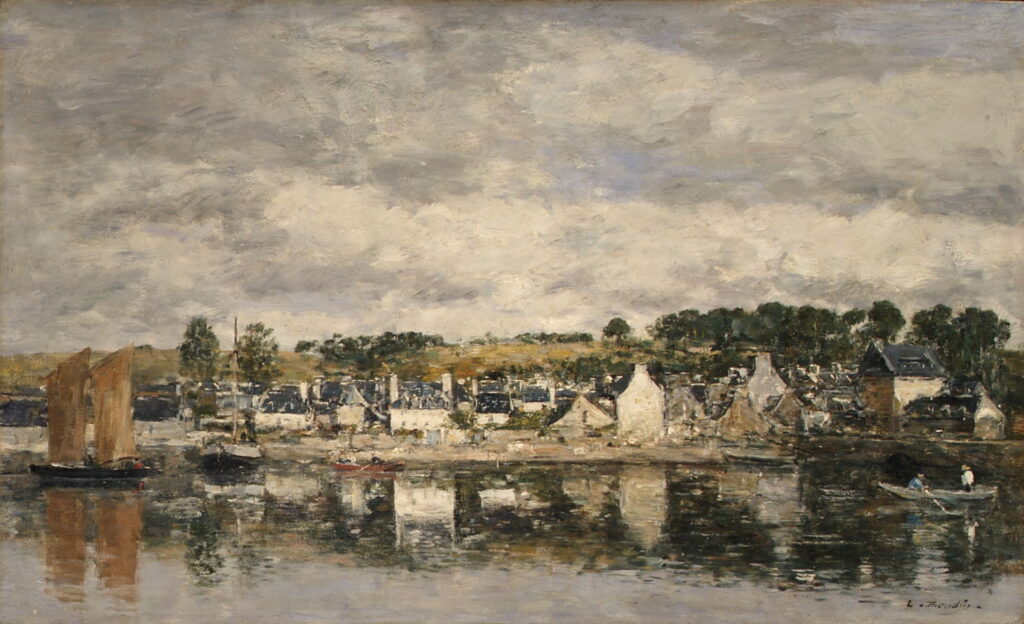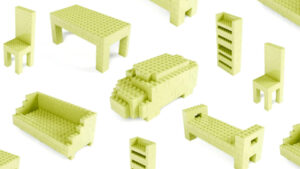200th anniversary of Eugène Boudin: Pioneer of Impressionism 1

In a week’s time, I will be marking the bicentenary of the birth of one of the most important influences on French Impressionist art, who mentored the young Claude Monet, and exhibited at the First Impressionist Exhibition in 1874: Eugène Louis Boudin, who was born on 12 July 1824. This is the first of two articles briefly tracing his career and influence, with a selection of his paintings.
Boudin was born in Honfleur, on the north coast of France at the mouth of the River Seine opposite Le Havre. His father worked on the ferry making the short crossing to Le Havre, and in 1835 the family moved to Le Havre, where the following year Eugène started work at a printer’s then in a stationery shop.
In 1844 he opened his own stationers that also framed paintings, but the following year Millet saw some of his amateur paintings, and Boudin resolved to make painting his future. His shop framed the work of, and sold art materials to, Couture, Troyon, and Millet. It was a centre of artistic activity which attracted the young Claude Monet, who also grew up in Le Havre, to seek Boudin’s counsel and instruction.
By 1847, Boudin had made his way to Paris, where he started to study paintings in museums and galleries. He returned to Le Havre, and in 1851 was awarded a scholarship by his local council to study painting in Paris. His application was supported by Thomas Couture and Constant Troyon.
Until 1860, he lived in Paris, copying paintings in the Louvre, and returned to the north coast to paint there en plein air whenever he could. However, he didn’t apparently engage in the anticipated studies at the École des Beaux-Arts, and remained largely self-taught. He had his first painting accepted for the Salon of 1859, two years later he worked with Troyon, and the following year made friends with Jongkind. Two years later he met with Monet and Jongkind and the three painted together in Honfleur.
Eugène Boudin (1824–1898), Pardon of Sainte-Anne-La-Palud (study) (1858), oil on wood panel, 23.2 x 17.5 cm, Musée d’art moderne André Malraux, Le Havre, France. Wikimedia Commons.
On the last weekend in August, 1857, Boudin visited the Finistère region’s largest religious celebration, and made sketches in oils, including this study for The Pardon of Sainte-Anne-La-Palud (1858). These he used to paint a more traditionally finished oil painting, shown in the Paris Salon the following year, where it was praised by Baudelaire.
Eugène Boudin (1824–1898), The Beach (1864), oil on panel, 42 x 59 cm, Art Gallery of New South Wales, Sydney. Wikimedia Commons.
More typical of his early finished paintings, The Beach (1864) shows an assorted gathering beneath one of his wonderful skies. These became such a feature of his work that Corot dubbed him ‘master of the skies’.
Eugène Boudin (1824–1898), The Beach at Villerville (1864), oil on canvas, 45.7 × 76.3 cm, The National Gallery of Art, Washington, DC. Wikimedia Commons.
The Beach at Villerville (1864) shows a dusk setting unusual among his beach paintings. This is set in another small seaside community between Trouville and Honfleur.
Eugène Boudin (1824–1898), On the Beach, Dieppe (1864), oil on panel, 31.8 × 29.2 cm, Metropolitan Museum of Art, New York, NY. Wikimedia Commons.
Boudin travelled from Paris to paint On the Beach, Dieppe in 1864.
Eugène Boudin (1824–1898), Princess Pauline Metternich on the Beach (1865-7), oil on cardboard mounted on panel, 29.5 × 23.5 cm, Metropolitan Museum of Art, New York, NY. Wikimedia Commons.
For a while, Boudin painted celebrities including Princess Pauline Metternich on the Beach (1865-7) when they visited the seaside around Honfleur and Le Havre, but as he became more successful in the Salon, he dropped these opportunistic sketches.
Eugène Boudin (1824–1898), Village by a River (c 1867), oil on panel, 35.6 × 58.4 cm, Metropolitan Museum of Art, New York, NY. Wikimedia Commons.
He also painted many ports, ships and boats, and riverside scenes, such as Village by a River (c 1867), whose location remains uncertain.
Eugène Boudin (1824–1898), Lady in White on the Beach at Trouville (1869), oil on board, 55.3 x 38 cm, Musée d’art moderne André Malraux, Le Havre, France. Wikimedia Commons.
His oil sketches, here of a Lady in White on the Beach at Trouville (1869), were amazingly loose and painterly, and clear inspiration to Claude Monet and the Impressionists more generally.
He started to achieve commercial success in 1864, his income peaking in 1872, but declining thereafter. His friendship with and support to Monet resulted in him being invited to take part in the First Impressionist Exhibition in 1874. His first entry in its catalogue could be any of three paintings.
Eugène Boudin (1824–1898), Camaret, Le Toulinguet (c 1871), oil, 40 x 65.4 cm, Private collection. WikiArt.
The first two, both known as Camaret, Le Toulinguet (c 1871) and showing almost identical views, include the version above in a private collection, and another now in the Philadelphia Museum of Art (not shown). Boudin painted at Camaret, in Brittany, each year between 1870 and 1873.
Eugène Boudin (1824–1898), Camaret, Le Toulinguet (1872), oil, dimensions not known, Private Collection. WikiArt.
The third possibility is this, Camaret, Le Toulinguet (1872), in a private collection.
Eugène Boudin (1824–1898), Fishermen’s Wives at the Seaside (1872), oil on panel, 55.9 x 38.7 cm, Museum of Fine Arts, Houston, TX. Wikimedia Commons.
He also painted scenes of local people and their activities along the northern coast, such as this Fishermen’s Wives at the Seaside (1872).
According to the exhibition catalogue, Boudin showed a total of thirteen works in the First Impressionist Exhibition in Nadar’s studio in Paris, described as:
Le Toulinguet, côtes de Camaret, Finistère (see above),
Shore at Portrieux, Côtes du Nord (two paintings),
Four pastel sky studies,
Two other pastel studies,
Four watercolours of the beach at Trouville.
Quite a few of his watercolours have survived, and appear mostly quick plein air studies anticipating more substantial works in oil. Sadly, most of his pastels seem to have been lost, although this suggests that he used the medium relatively often.
References
Bergeret-Gourbin A-M (1996) Eugène Boudin. Peintures et Dessins. Catalogue Raisonné Musée Eugène Boudin Honfleur, Somogy Éditions d’Art. ISBN 978 2 8505 6250 1.
His latest catalogue raisonné is by R Schmit, in three main volumes, 1973, with two supplementary volumes, in 1984 and 1993, all published by Galerie Schmit, Paris.




